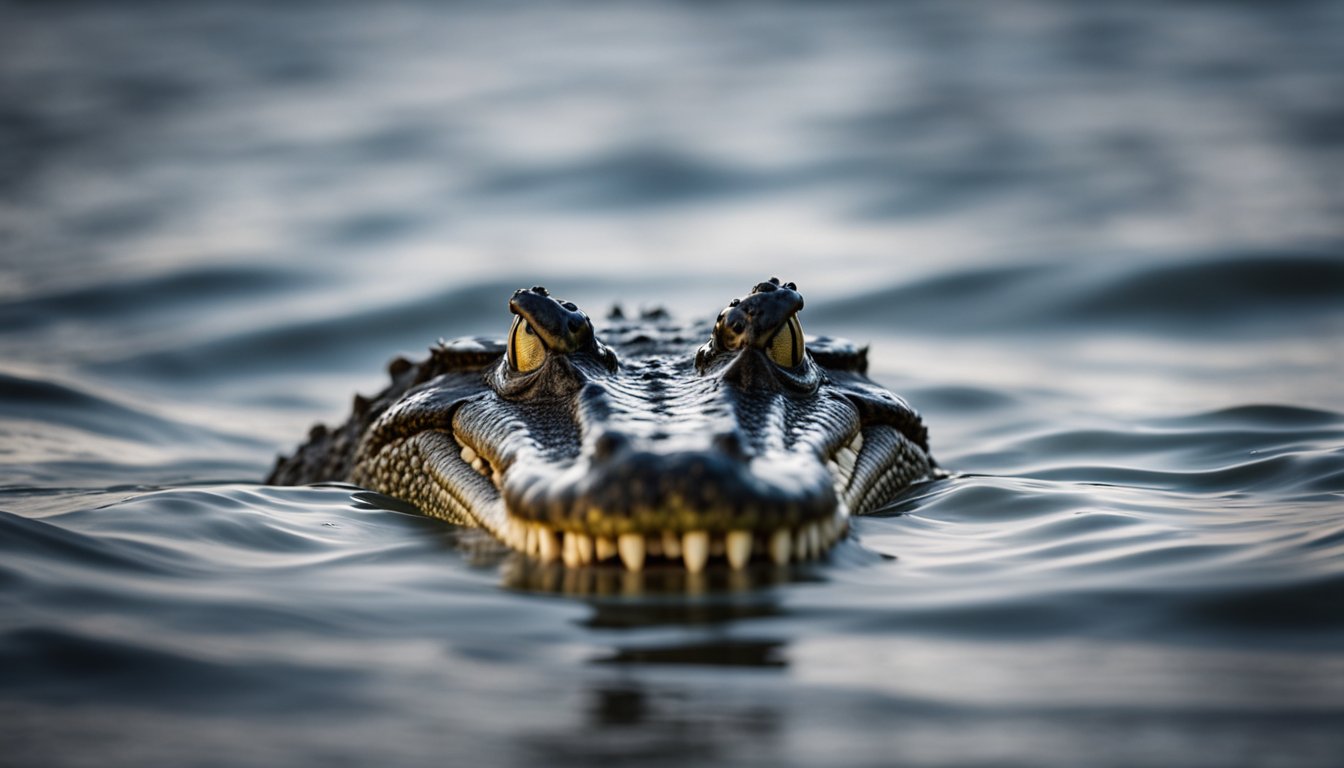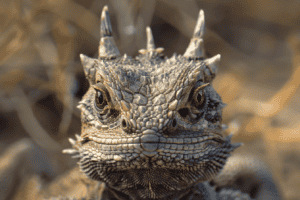Crocodiles are some of the most fascinating and ancient creatures on our planet.
With their thick, scaly armor and powerful jaws, they’ve captivated the imaginations of people for centuries.
These riveting river hunters have been around for more than 200 million years, outliving the dinosaurs and adapting to a variety of habitats around the world.
They are the apex predators in their environments, which means they sit at the top of the food chain, and with no natural enemies when they reach adulthood, they play a crucial role in maintaining the delicate balance of their ecosystems.

Have you ever wondered what it would be like to glide through the waters with the stealth and grace of a crocodile?
These incredible reptiles are masters of their realm, with bodies perfectly designed for a life of hunting and survival.
They have special valves in their noses and mouths that close off so they can stay submerged for up to an hour, lying in wait for an unsuspecting fish or mammal to come close enough for a sudden and deadly ambush.
Observing crocodiles in their natural habitats reveals a world of intricate behaviors and survival techniques.
They are social animals with a range of communications that include bellowing and hissing, and they care for their young with a tenderness that might surprise you.
Crocodile mothers will carry their newly hatched babies to the water in their mouths, protecting them from predators.
These reptilian parents fiercely guard their young, teaching us that even the most fearsome creatures have a gentle side.
Welcome to the realm of crocodiles – where every fact is as intriguing as the creatures themselves.
Crocodile Species Showcase
Exploring the world of crocodiles, one may encounter a variety of species, each with unique features and adaptations suited to their environments.
Here, the spotlight shines on two distinct types – one thriving in freshwaters and the other ruling saline ecosystems.
Freshwater Fossils – Crocodylus Siamensis
Crocodylus siamensis, commonly known as the Siamese crocodile, is a freshwater species that one may find hidden in the lush waterways of Southeast Asia.
Often lurking in slow-moving rivers, wetlands, and lakes, these reptiles possess a more subdued demeanor compared to their saltwater cousins.
They exhibit armor-like scales and a broad snout, and typically they measure up to 3 meters in length, though some individuals grow larger.
Once thought to be nearly extinct in the wild, conservation efforts have facilitated modest rebounds in their population, igniting a glimmer of hope for their future.
Saltwater Giants – Crocodylus Porosus
Turning to the brackish mangroves and ocean outreaches, Crocodylus porosus holds the title of the largest living reptile on Earth.
Known as the saltwater crocodile, they are true behemoths with extraordinary strength and a powerful presence.
They reign in regions spanning from India’s east coast to northern Australia, showcasing lengths that can exceed a staggering 7 meters.
Their exceptional adaptability allows them to thrive in a variety of saline environments, and their nictitating membrane and salt glands enable them to clear excess salt from their bodies – truly remarkable adaptations for an estuarine existence.
These giants command respect, with a bite force that one can only describe as thunderous, reminding all of their place at the pinnacle of their ecological niche.
Physical Characteristics

Crocodiles fascinate with a suite of physical traits that are both imposing and intricate.
Let’s wade into the details of their armored bodies, powerful jaws, and the unique smile-cum-sensory system.
Armor-Clad Bodies
Imagine wearing a coat of armor every day of your life.
That’s the reality for a crocodile, with its bony scales called osteoderms reinforcing the skin on their back.
These scales act as a formidable shield.
Yet, this isn’t just for defense; it also serves crocodiles in regulating their body temperature, absorbing heat when they bask in the sun’s generous rays.
Powerful Jaws and Sharp Teeth
Have you ever tried to break open a tough nut? It’s no sweat for a crocodile.
Their jaw muscles can clamp down with astonishing force, making them one of the animal kingdom’s most powerful biters.
Each crocodile has about 24 conical teeth on each side of both jaws, equipping them splendidly for grabbing and holding onto slippery prey.
The Crocodile Smile – Sensory Pits
The crocodile’s smile hides a secret: tiny black dots that dot their jaws are actually sophisticated sensory pits.
Think of them as nature’s radar systems, detecting tiny changes in water pressure and enabling crocodiles to sense approaching meals or predators, turning them into adept hunters even in murky waters.
Hunting Techniques and Diet

Crocodiles are magnificent aquatic hunters, famed for their patient hunting strategies and unexpected dietary habits.
Stealthy Predators
When it comes to hunting, crocodiles are the epitome of patience and precision.
They can remain nearly motionless for hours, waiting for an unsuspecting meal to come within reach.
Camouflaged by their environment, they blend seamlessly into the landscape.
A crocodile’s approach is often slow and calculated, moving through the water without causing a ripple.
With eyes and nostrils positioned on top of their heads, they can keep a low profile while observing their surroundings.
Once the prey is within striking distance, they launch an explosive attack with lightning speed, seizing it with their powerful jaws.
Surprising Diet Discoveries
Despite their ferocious reputation, crocodiles have a diet that can surprise you.
While they are capable of taking down large prey, such as zebras and wildebeest, crocodiles are not exclusively meat-eaters.
They are known to complement their diet with fruits and nuts that drop into the water.
This behavior suggests that crocodiles may play a role in dispersing plant seeds, acting as unexpected gardeners of their ecosystems.
Young crocodiles tend to feast on smaller prey such as insects and small aquatic invertebrates before graduating to larger fare as they grow.
Have you ever wondered what a crocodile might eat besides the obvious fish or zebra?
It’s fascinating to think of these fierce creatures munching on berries or fruits amidst their aquatic homes.
Habitats and Conservation

Crocodiles are fascinating creatures, often found lurking in the waters of rivers, lakes, and swamps, their eyes and nostrils just above the surface.
They’ve claimed a variety of wetland habitats across the globe, but human activities are putting these powerful reptiles at risk.
Let’s venture into the world where they roam and discover how they are being protected.
Marshes and Mangroves
The marshes and mangroves offer a perfect hideaway for crocodiles, providing ample food and shelter.
In these lush, green waterways, crocodiles can camouflage themselves among the roots and leaves.
They thrive in the warm marsh waters, which are teeming with fish, while the dense mangrove forests are ideal for nesting.
These habitats are vital for their survival, yet they are diminishing due to industrial development and climate change.
Human Interactions and Conservation Efforts
Humans and crocodiles have a complex relationship. As people encroach on crocodilian habitats for agriculture and settlements, conflicts can arise.
Yet, it’s not all gloomy for these river hunters. Global conservation efforts are providing them a lifeline.
Strict laws and protected areas help ensure that crocodile populations can recover from past hunting pressures.
By realizing the value these predators have in maintaining a balanced ecosystem, conservationists work with local communities to protect crocodiles, safeguarding their future.
This collaboration is a beacon of hope, highlighting the importance of coexistence between humans and crocodiles.
Frequently Asked Questions

Ever wonder how crocodiles became such powerful predators or which animals could actually challenge them?
Let’s dive into some incredible crocodile curiosities that arouse wonder and awe!
What incredible abilities help crocodiles to be such successful hunters in their watery worlds?
Crocodiles are equipped with keen eyesight, rugged armored skin, and powerful jaws that snap shut with lethal force.
They use a stealthy approach, lurking just beneath the water’s surface as they home in on their unsuspecting prey.
It’s their patience and perfect timing, coupled with explosive power, that make these river hunters so remarkably efficient.
How do saltwater crocodiles measure up in the grand scale of crocodilian size, and just how big have they been known to grow?
Saltwater crocodiles are the largest of all living reptiles. They can grow to be over 20 feet long and weigh more than 2,200 pounds!
The largest saltwater crocodile ever recorded stretched a massive 23 feet, making them true giants among their kind.
Can you believe there are creatures out there that could stand toe-to-toe with a crocodile?
What animals have the power to challenge these tough reptiles?
Despite their formidable prowess, crocodiles do face some impressive foes.
Large felines like lions and tigers can pose a threat on land, while sharks may challenge them in water.
However, these encounters are rare and often end in a stalemate, with both parties preferring to avoid costly confrontations.
Have you heard about the Dominator? Discover some jaw-dropping stories about the largest crocodiles ever spotted!
The Dominator, a legendary crocodile from Australia, is rumored to measure up to 20 feet in length.
While not officially measured, these stories contribute to the awe surrounding the immense size that saltwater crocodiles can achieve.
Such accounts capture the imagination and demonstrate the extreme scale of these river monsters.
Why are crocodiles considered one of nature’s most effective predators, and what strategies do they use to catch their prey?
Crocodiles utilize a combination of stealth, power, and a ‘sit-and-wait’ strategy to capture their prey.
They patiently bide their time, floating like logs in the water before launching a surprise attack with lightning speed.
Their sensor-laden snouts can detect pressure changes, allowing them to sense the movements of potential prey nearby.
Are there any fearsome predators that pose a threat to the mighty saltwater crocodiles, or do they reign supreme in their habitat?
In their aquatic territories, saltwater crocodiles have few natural enemies and often sit at the top of the food chain.
However, they must be wary of humans, their largest threat, due to habitat loss and hunting.
Occasionally, sharks and larger crocodiles can become rival predators or competitors, but salties are generally the apex predators in their environment.









